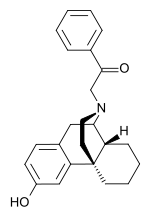Levophenacylmorphan
Levophenacylmorphan is a morphinan derivative that acts as an opioid agonist. It has potent analgesic effects and is around 10x more potent than morphine.[1] Adverse effects associated with its use are those of the opioids as a whole, including pruritus, nausea, respiratory depression, euphoria and development of tolerance and dependence to its effects.[2]
 | |
| Clinical data | |
|---|---|
| Other names | Levophenacylmorphan |
| ATC code |
|
| Legal status | |
| Legal status |
|
| Identifiers | |
| |
| CAS Number | |
| PubChem CID | |
| ChemSpider | |
| UNII | |
| CompTox Dashboard (EPA) | |
| ECHA InfoCard | 100.030.168 |
| Chemical and physical data | |
| Formula | C24H27NO2 |
| Molar mass | 361.485 g·mol−1 |
| 3D model (JSmol) | |
| |
| |
| | |
References
- MAY, E.L. & EDDY, N.B., A New Potent Synthetic Analgesic, J. Org. Chem., 24 : 294, 1959.
- Fraser HF, Isbell H. Human pharmacology and addiction liabilities of phenazocine and levophenacylmorphan. UN Bulletin on Narcotics. 1960 Issue 2
This article is issued from Wikipedia. The text is licensed under Creative Commons - Attribution - Sharealike. Additional terms may apply for the media files.